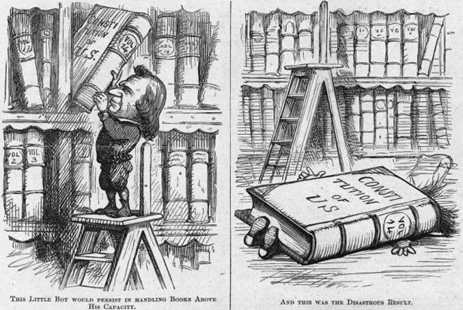”I protest again the admission of any ex-rebels into the great partnership of the Republic…States which [quickly sent] themselves out of Congress must not be allowed to [quickly send] themselves back. They must not be allowed back into these halls which they treasonably deserted….[At the end of the war], the rebels were vanquished and they knew it…Had the national government taken advantage of this plastic condition, it might have stamped equal rights upon the whole people, as upon molten wax.”
The speaker of the above quote most likely supported –
A. The Ten Percent Plan
Incorrect. This quote supports fairly strict conditions to readmit the South, including equal rights, neither of which were features of the Ten Percent plan. The speaker of this quote is Charles Sumner, a leading Radical Republican, and supporter of the Reconstruction Act of 1867.
B. Presidential Reconstruction
Incorrect. This quote supports fairly strict conditions to readmit the South, including equal rights, neither of which were features of Presidential Reconstruction. The speaker of this quote is Charles Sumner, a leading Radical Republican, and supporter of the Reconstruction Act of 1867.
C. The Reconstruction Act of 1867
Correct! This quote supports fairly strict conditions to readmit the South, including equal rights, which were features of the Reconstruction Act of 1867. The speaker of this quote is Charles Sumner, a leading Radical Republican, and supporter of the Reconstruction Act of 1867.
D. The Compromise of 1877
Incorrect. The Compromise of 1877 ended Reconstruction and essentially gave up on equal rights for the whole people, which this quote strongly supports. The speaker of this quote is Charles Sumner, a leading Radical Republican, and supporter of the Reconstruction Act of 1867.

The above political cartoon —
A. supports the re-election of Andrew Johnson
Incorrect. By portraying Johnson as a “little boy” getting flattened by the Constitution, the cartoon clearly opposes the President.
B. suggests that Andrew Johnson was not capable of doing the job of President
Correct! By portraying Johnson as a “little boy” getting flattened by the Constitution, the cartoon clearly opposes the President. The cartoon suggests the President was incapable of handling such big things like the 14th Amendment.
C. opposes the ratification of the 14th Amendment to the Constitution as a “disastrous result”
Incorrect. The disastrous result was the crushing of the President by the 14th Amendment, not its ratification. The cartoon suggests the President was incapable of handling such big things like the 14th Amendment.
D. opposes Radical Reconstruction
Incorrect. The 14th Amendment was a key part of Radical Reconstruction, and this cartoon clearly supports it.
"Such measures will be taken as will inform all [former slaves] entitled to be registered, of the necessity for, and the time and place of registration, and the time and place of voting. They will also be instructed as they will not be allowed to suffer from the honest exercise of the right of suffrage, they should disregard all threats." ‐Dispatch to Richmond, VA, May 1, 1867
The author of these instructions was most likely —
A. an officer of the military district government
Correct! These orders were given by a general in the military government of Virginia to the Freedman’s Bureau, instructing them to prepare the freed slaves to vote.
B. Abraham Lincoln
Incorrect. These orders were given by a general in the military government of Virginia to the Freedman’s Bureau, instructing them to prepare the freed slaves to vote. While Lincoln would be sympathetic to these orders, he was not alive in 1867.
C. an opponent of Radical Reconstruction
Incorrect. These orders were given by a general in the military government of Virginia to the Freedman’s Bureau, instructing them to prepare the freed slaves to vote. This was part of Radical Reconstruction.
D. a member of the Ku Klux Klan
Incorrect. These orders were given by a general in the military government of Virginia to the Freedman’s Bureau, instructing them to prepare the freed slaves to vote. Members of the Ku Klux Klan would be the people making threats to freed slaves trying to prevent them from voting.
Which of the following was a condition of the Reconstruction Act of 1867?
A. ten percent of all of rebels eligible to vote in 1860 must swear an oath of allegiance to the United States
Incorrect. This was the main feature of Lincoln’s “Ten Percent” plan. The requirement of a guarantee of the right to vote was a key feature of the Reconstruction Act of 1867.
B. states must ratify the 13th Amendment
Incorrect. This was a feature of Johnson’s Presidential Reconstruction. By 1867, the amendment had already been ratified.
C. new state constitutions must guarantee freedmen the right to vote
Correct! The requirement of a guarantee of the right to vote was a key feature of the Reconstruction Act of 1867.
D. at least one Democrat must be included in the Cabinet of the President
Incorrect. The inclusion of a Democrat in the Cabinet of the President was a feature of the Compromise of 1877, ending Reconstruction.
The election of which of the following presidents effectively ended Reconstruction?
A. Andrew Johnson
Incorrect. The strong opposition to President Johnson began Congressional Reconstruction. The Compromise of 1877, securing the election of Hayes ended Reconstruction.
B. Ulysses S. Grant
Incorrect. Grant was president for most of Radical Reconstruction. The Compromise of 1877, securing the election of Hayes, ended Reconstruction.
C. Samuel Tilden
Incorrect. Tilden received the most popular votes in the Election of 1876 but lost the presidency to Rutherford B. Hayes through the Compromise of 1877. As part of the deal, Reconstruction ended.
D. Rutherford B. Hayes
Correct! The election of Hayes through the Compromise of 1877 ended Reconstruction.